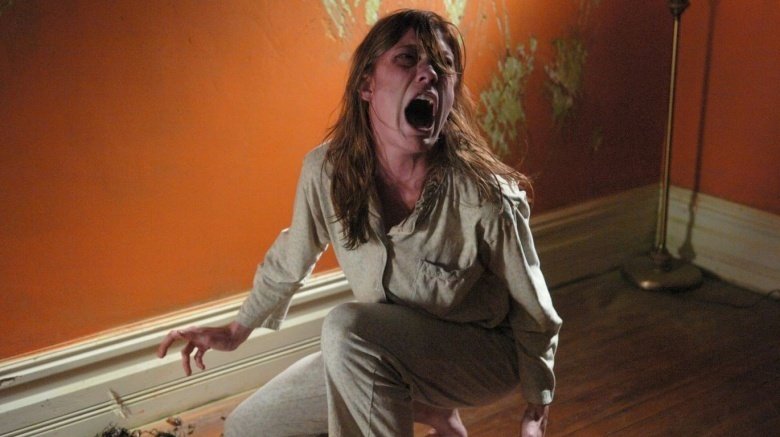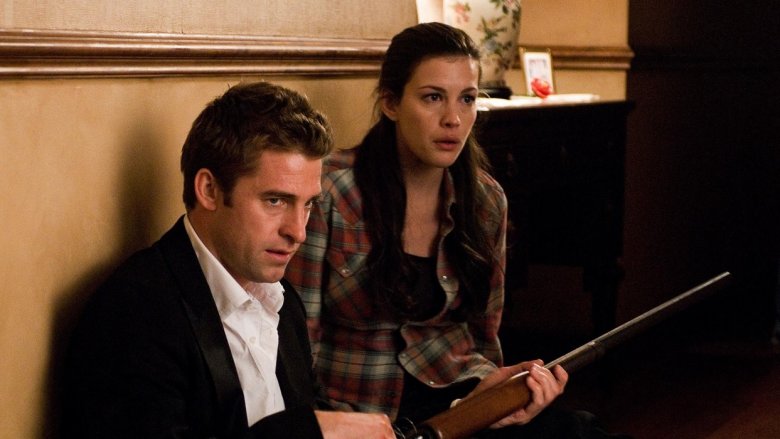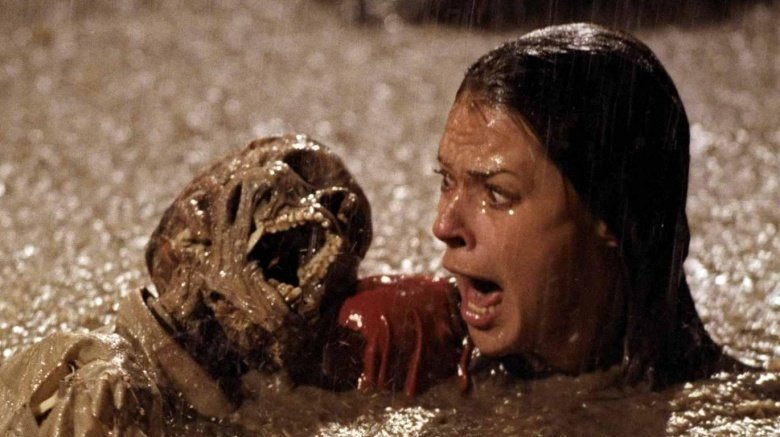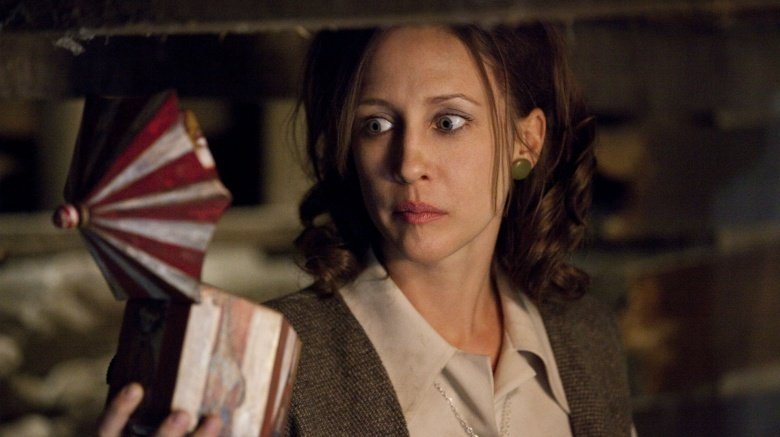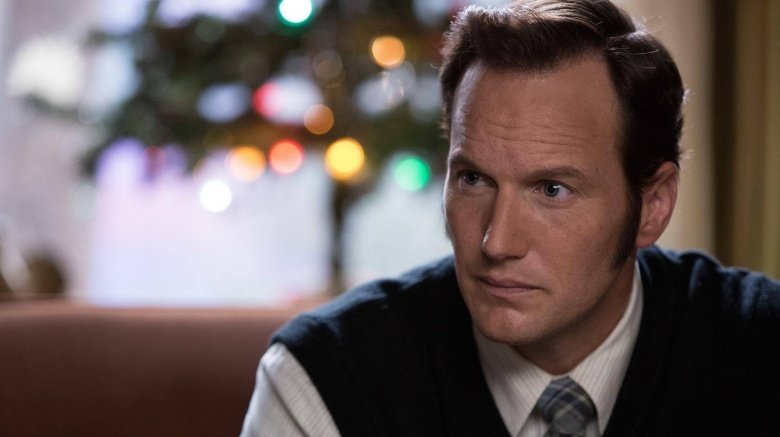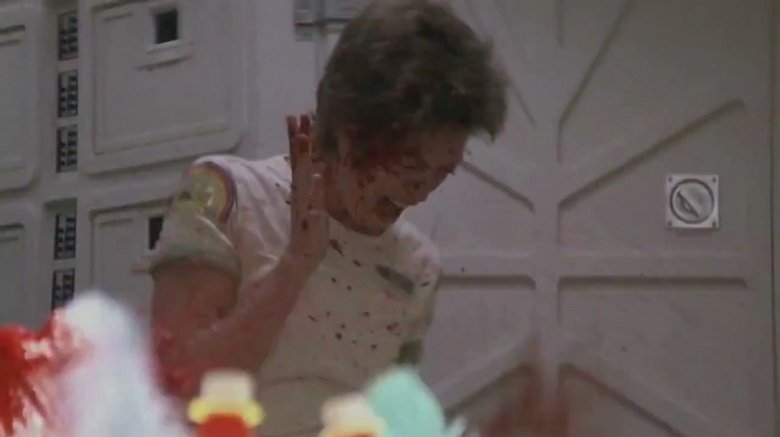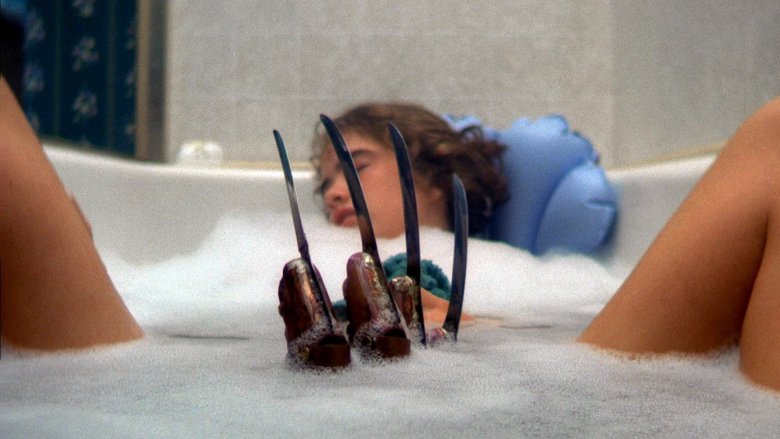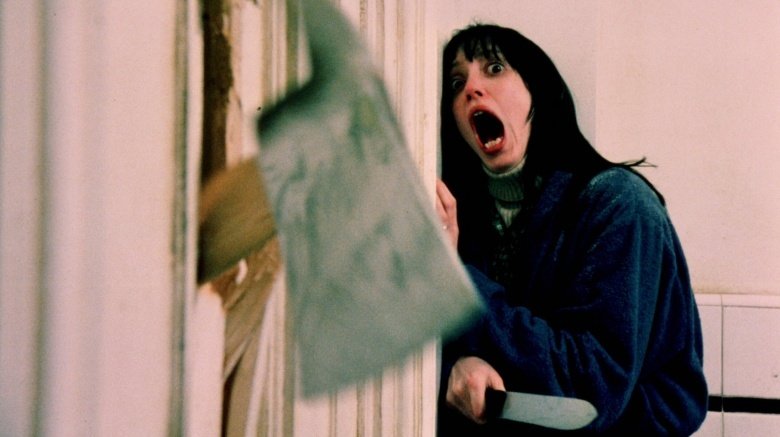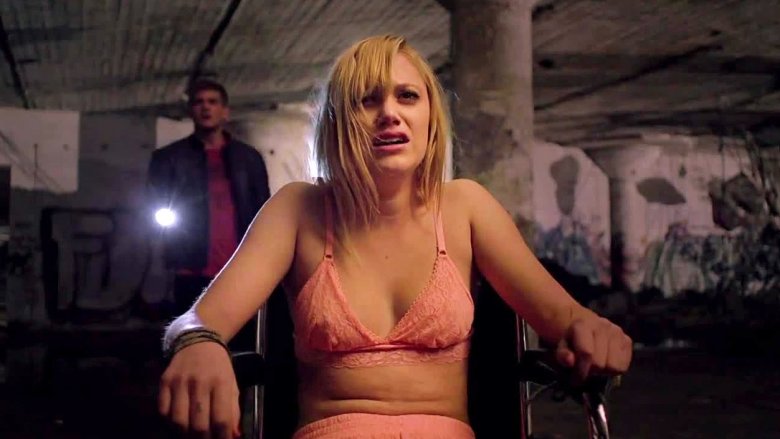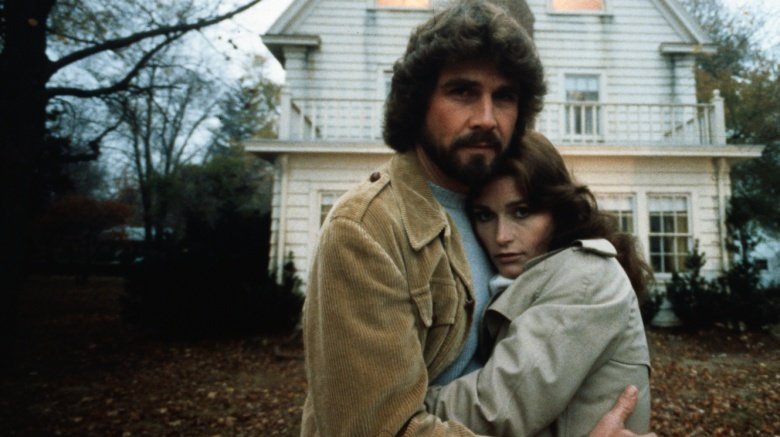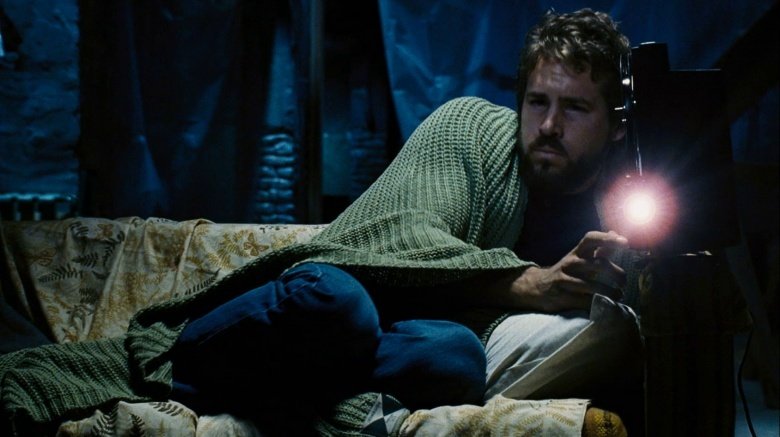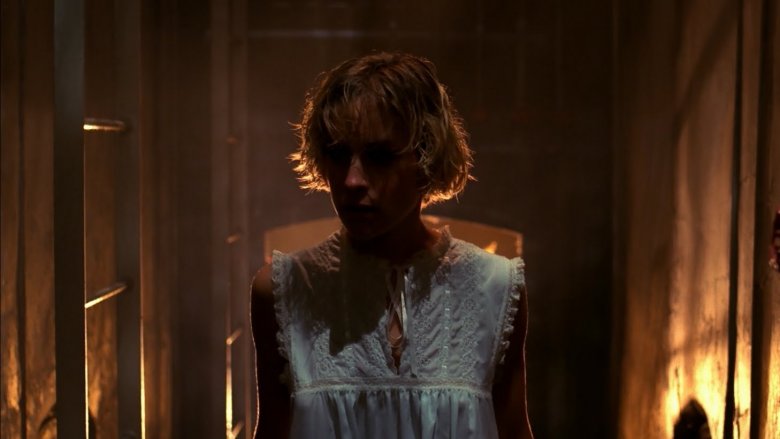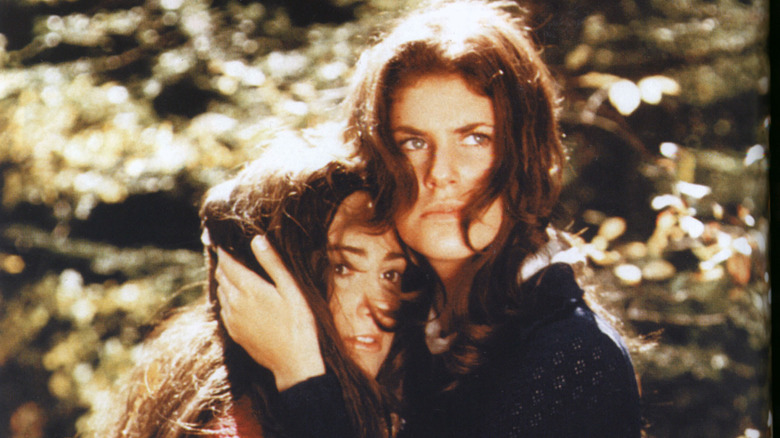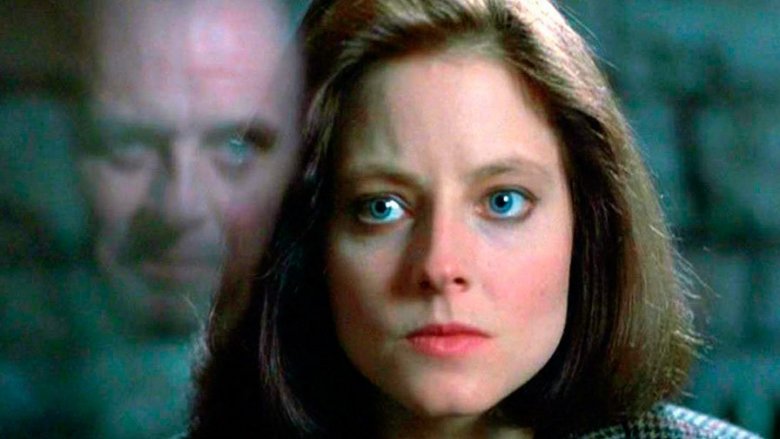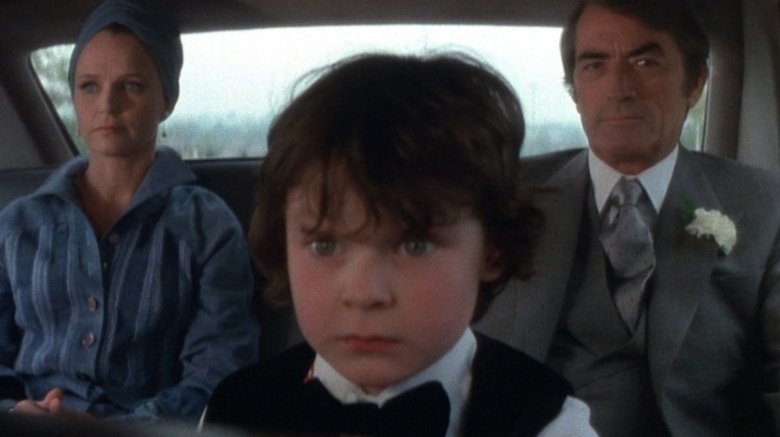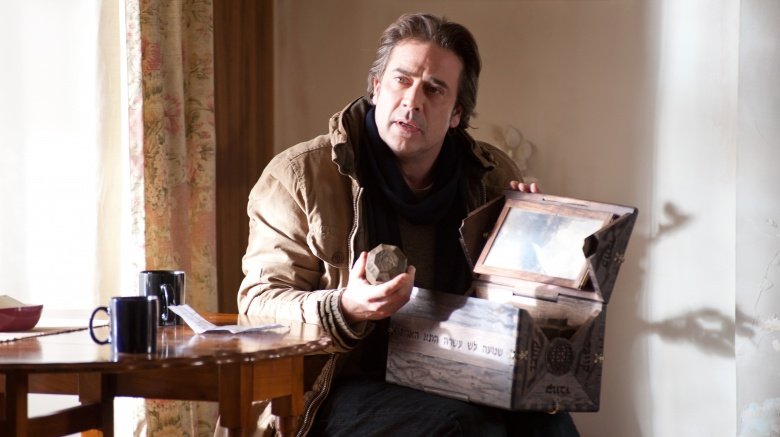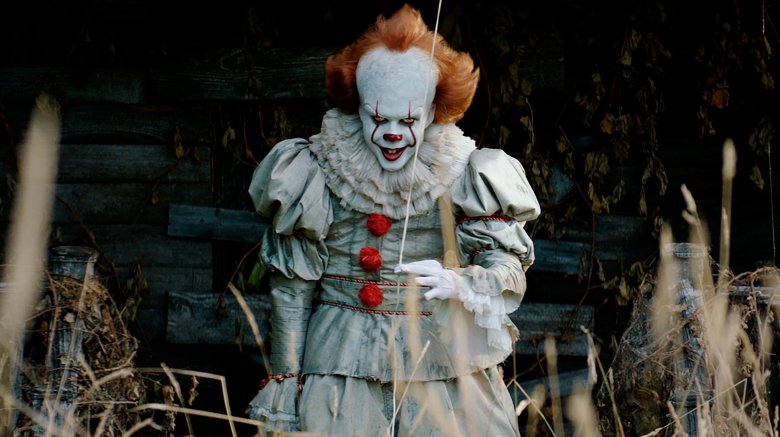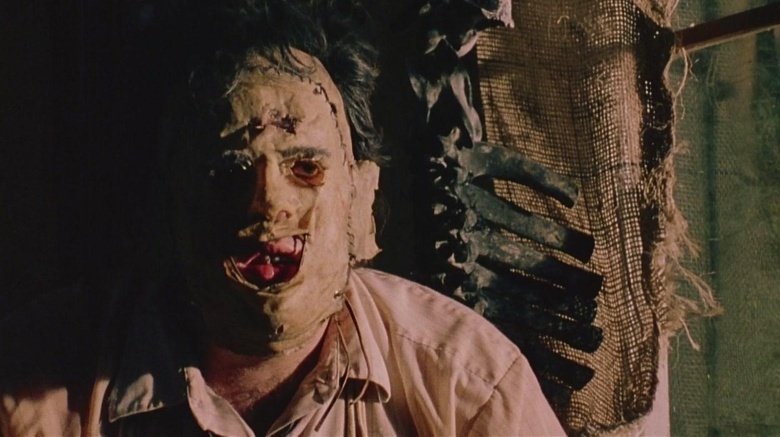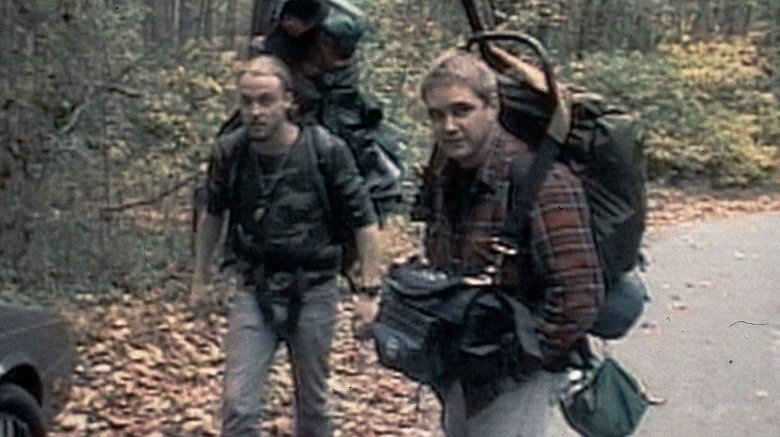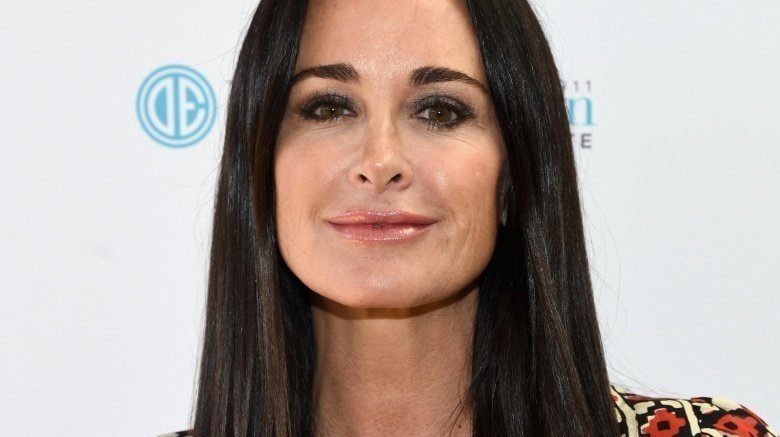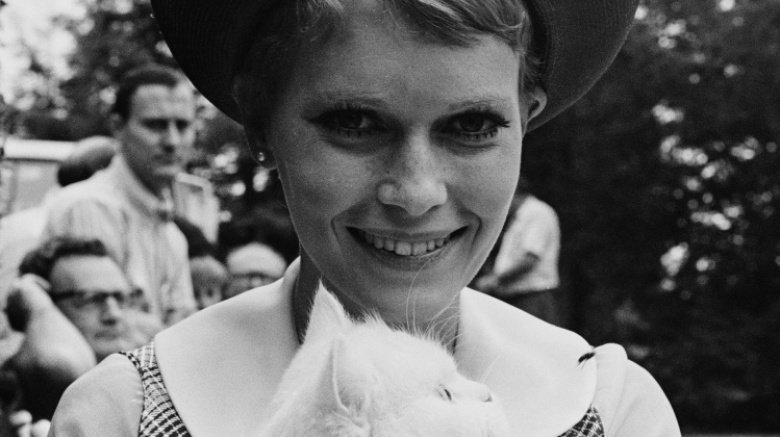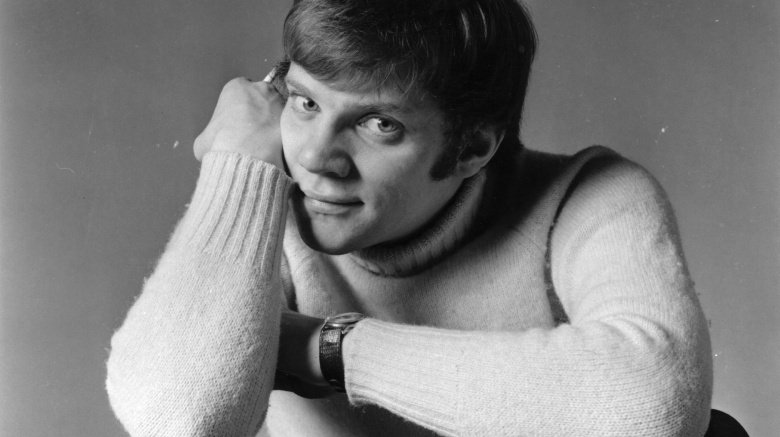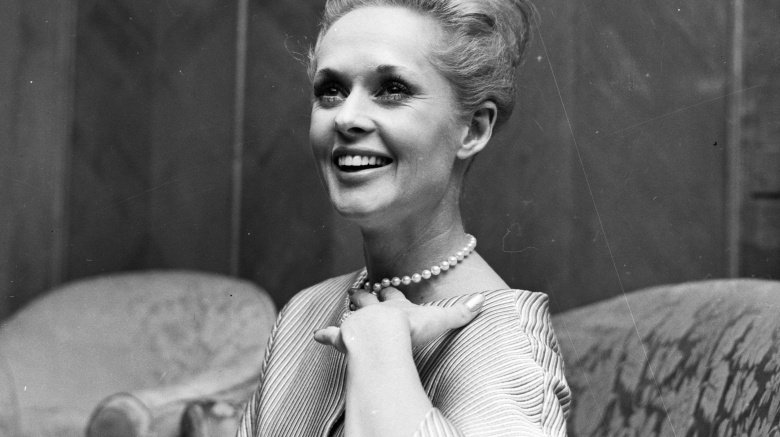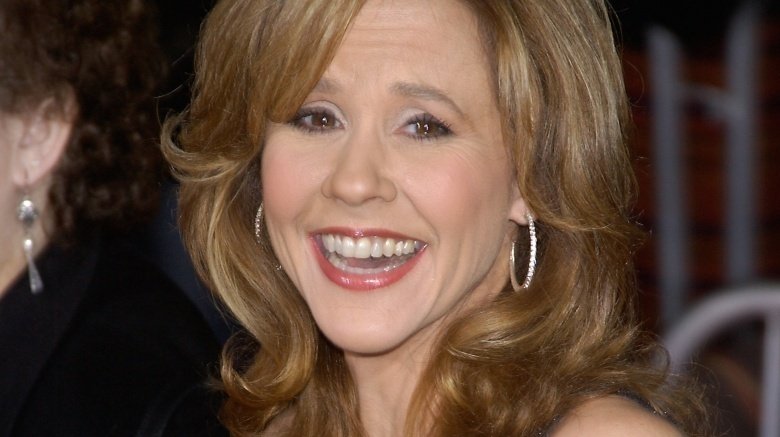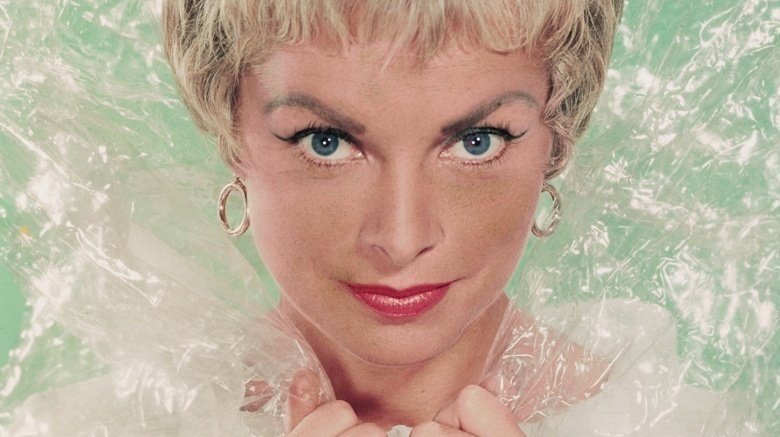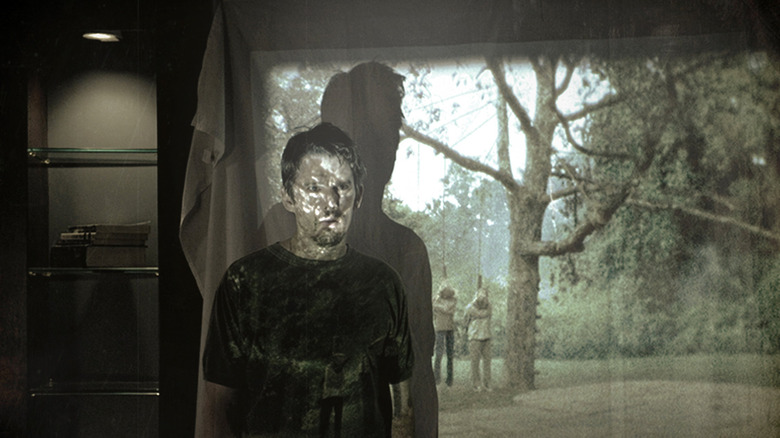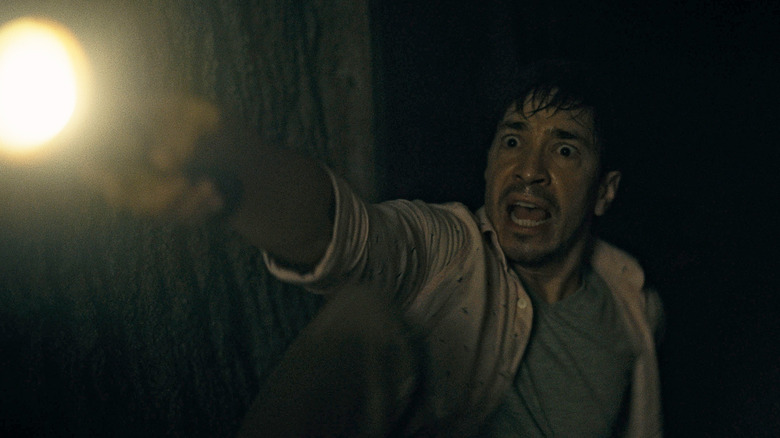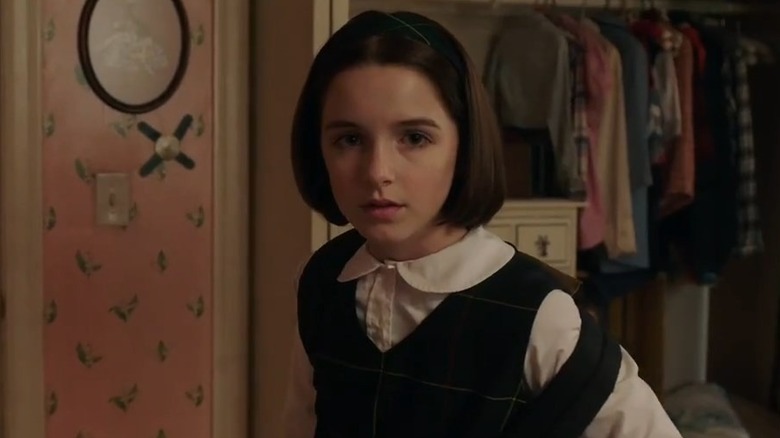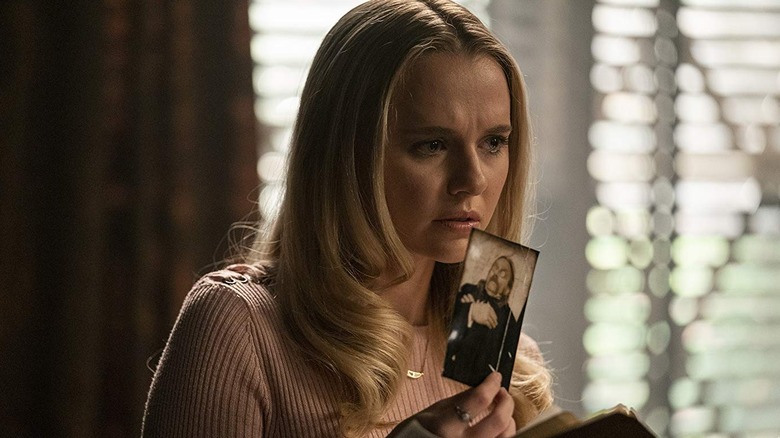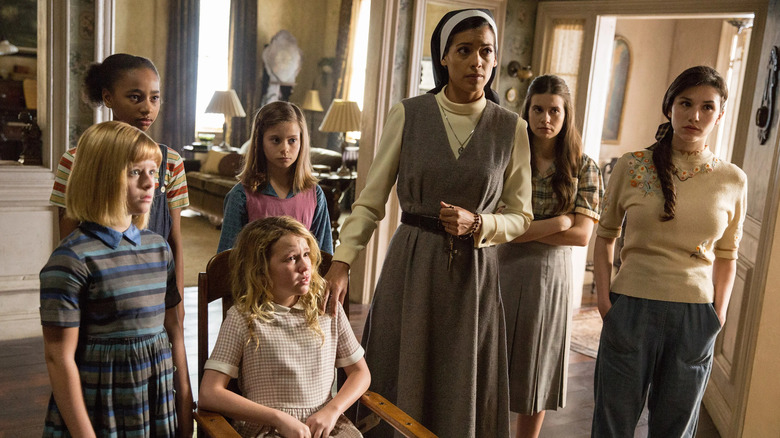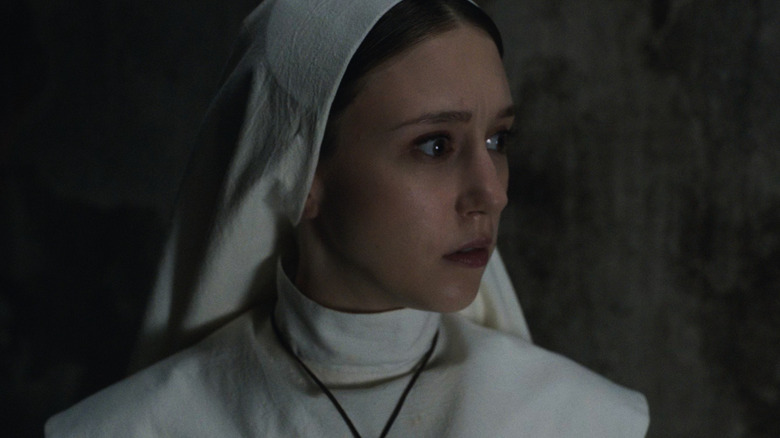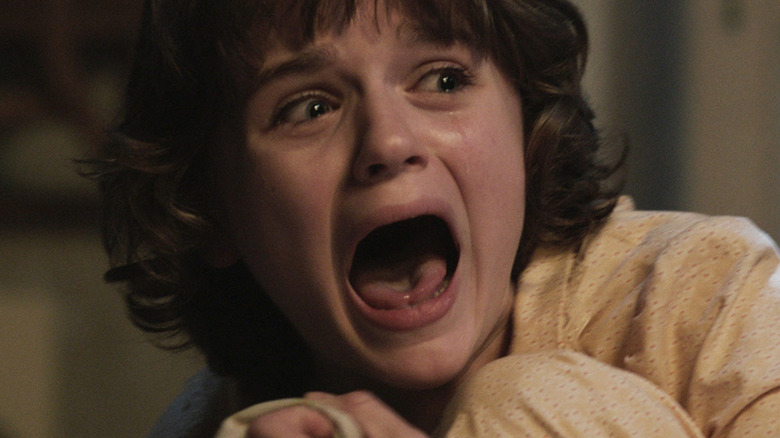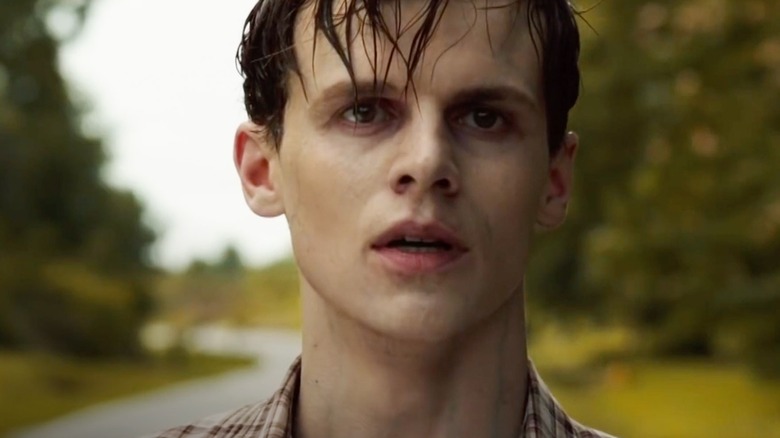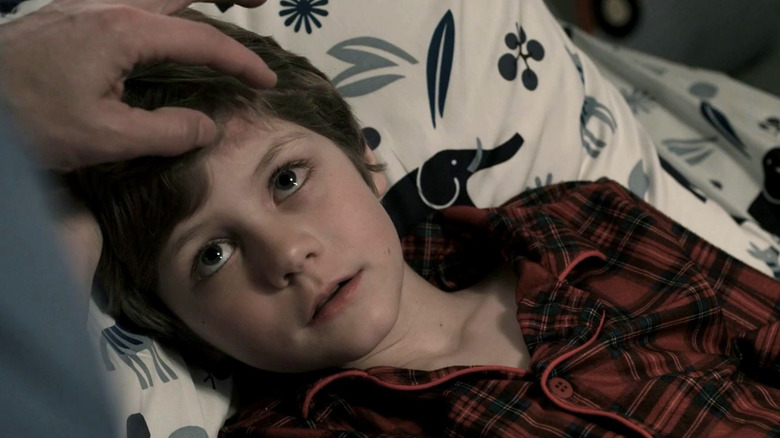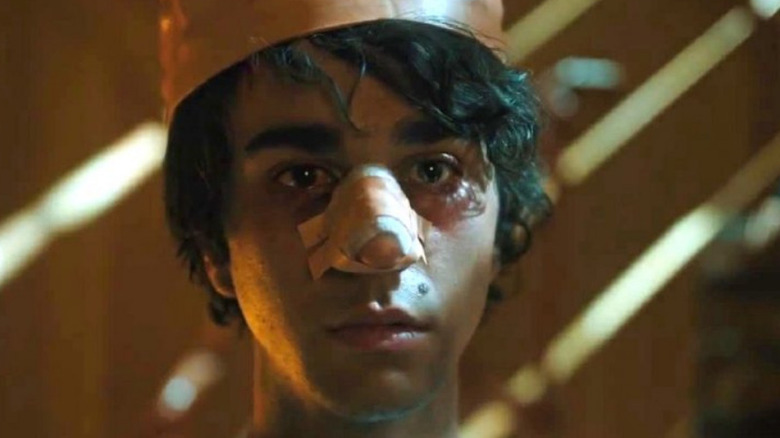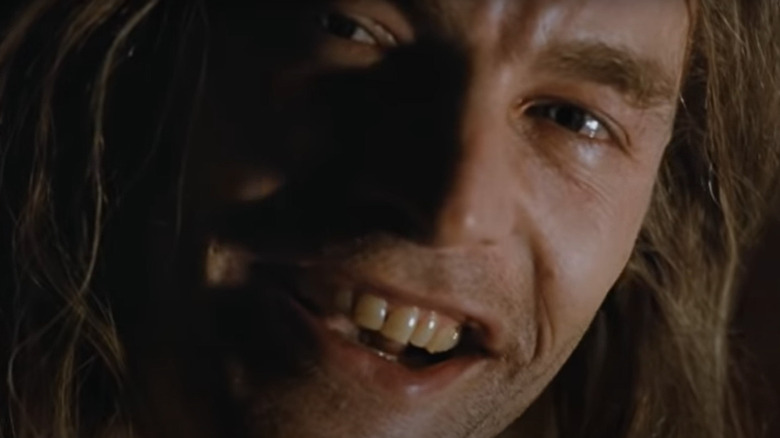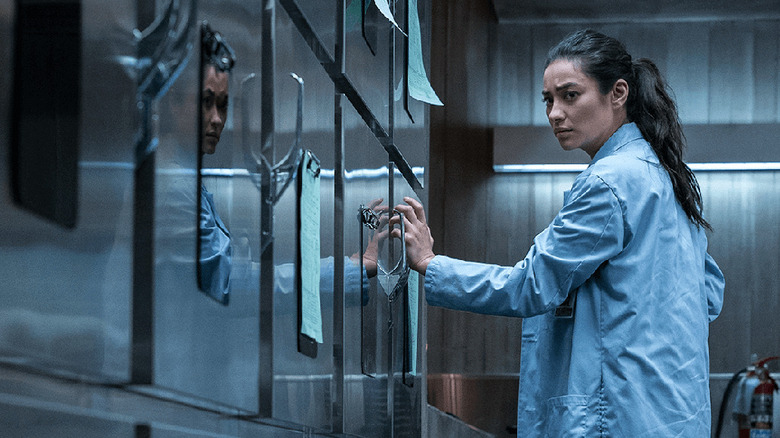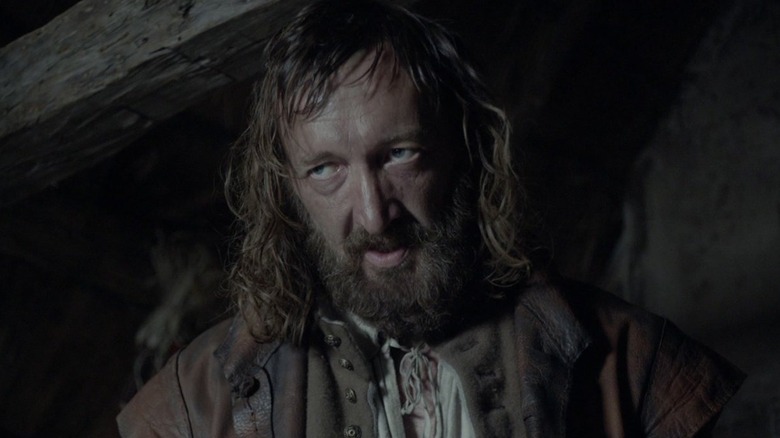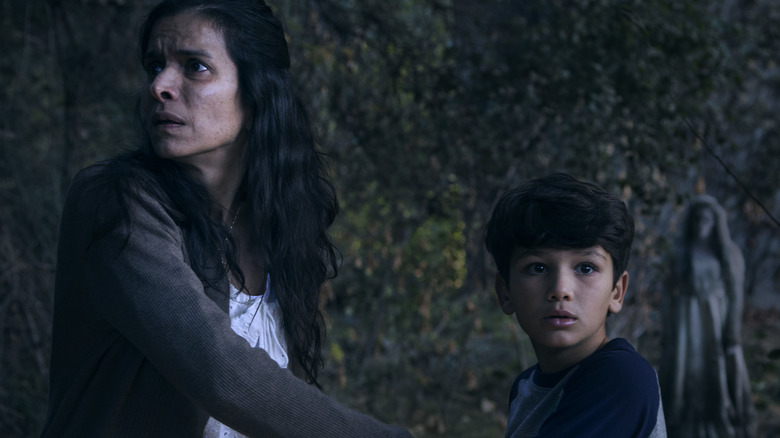Horror Roles That Really Messed Up The Actors' Heads
Have you ever watched a horror movie and wondered how these actors get through such terrifying, disturbing roles? While many actors are highly skilled at guarding their personal and emotional well-being while playing haunting roles, others are not so lucky. From working with abusive directors, to method acting gone wrong, here are some actors who took on horror roles that really messed up their minds.
Jennifer Carpenter in The Exorcism of Emily Rose (2005)
Jennifer Carpenter might've been fine with all the sinister surgical procedures going down on "Dexter," but the actress got a case of the spooks during production on "The Exorcism of Emily Rose." She told Dread Central that while she was filming the religious thriller, some strange things started happening to her after hours, like her radio randomly turning on in the middle of the night. "Two or three times when I was going to sleep my radio came on by itself," she said. "The only time it scared me was once because it was really loud, and it was Pearl Jam's 'Alive.'"
She wasn't the only one to experience such supernatural phenomena on the set, either; co-star Laura Linney's television repeatedly turned itself on at night during the shoot. Shiver. Carpenter later chalked up these happenings to some electrical issue with the hotel where they were staying, but she was also really glad the clock didn't read 3:00 a.m. when it happened, since that was such a horrifyingly significant time in the movie.
Liv Tyler in The Strangers (2008)
Despite getting mixed reviews, Bryan Bertino's low budget home invasion horror "The Strangers" made a hefty profit at the box office in 2008, raking in $82 million on a budget of just $9 million. Liv Tyler and Scott Speedman star as a couple whose remote getaway becomes a nightmare after three torturous strangers in masks show up. Variety's Dennis Harvey was one of the critics who praised the movie, lauding the two leads for "credibly registering every hue of panic."
According to Tyler, her reactions were credible because she was legitimately terrified. When NewsBlaze asked her if she was actually scared on set, she replied: "Oh yeah. I mean, all the time. Absolutely. That's what is so real about 'The Strangers.' Like, you'd be in bed at night trying to relax, and all of a sudden you hear a noise, and you go, 'What was that!' And you wonder, are you brave enough to go check or not. Imagine if you went to look, and there's a person in a mask standing in your living room, with a butcher knife!"
Actress Laura Margolis (who plays the "Pin-Up Girl" intruder) revealed on the Blu-ray extras that she'd been told Tyler wanted to feel genuine fear during their scenes together. "I got strict instructions not to let Liv see me in my mask before we shot," she said (via ComicBook.com). "She didn't want to have to fake it, and so it was my responsibility to really scare her."
JoBeth Williams in Poltergeist (1982)
This creepy 1982 classic is widely regarded to be one of the most cursed film sets of all time. Among the many mysterious tragedies associated with the pic were when actor Oliver Robbins had a near-death experience with the clown puppet during production, young actress Heather O'Rourke died a few years after the movie's release from a misdiagnosed intestinal abnormality, and actress Dominique Dunne was murdered by her ex-boyfriend in her driveway.
Actress JoBeth Williams, who portrayed the mother to the movie kids, was also shocked to find out that screenwriter-producer Steven Spielberg insisted on using real human skeletal remains as props for the movie, and she started getting freaked out by something weird that happened in her home at the time. As she explained during her Reddit AMA, "Because we were supposed to be scared so much, I think everybody's nerves were hypersensitive. I didn't live in L.A. then, so I was in a rented apartment, and I began to notice that every night when I would come home from shooting, exhausted, fried, the pictures on the walls would be crooked. And I would straighten them. And the next day, I would come in, and the pictures would be crooked again." She later convinced herself that the chills were of her own making as she slammed the door too hard on her way out, but at the time, it gave her an understandable case of the willies.
Vera Farmiga in The Conjuring (2013)
The real-life ghost-hunting history of Ed and Lorraine Warren is freaky enough to put anyone on edge, but Vera Farmiga knew very little of her character's counterpart before signing the dotted line on "The Conjuring" and receiving her first paranormal encounter as a welcome gift. The actress told Cinema Blend that during her first round of research into Warren's work she had a brush with the beyond after she hung up the phone with director James Wan and opened her laptop to find "three digital claw marks, from the upper right diagonal to the lower left."
Those marks would make a second unsettling showing in Farmiga's "Conjuring" experience the day after she finished shooting the first film and returned to her home in New York. She woke up to find a similar set of markings on her thigh. "It was these three, very distinct, what looks like claw marks, that long nails or long fingertips ... could make," she explained. Even though she chose not to "give into the fear" of the moment, she said "there's clear evidence of some strangeness that's occurred. My husband did not do that to me. I did not scratch some mosquito bite. It's inexplicable."
Patrick Wilson in The Conjuring 2 (2016)
When it comes to this genre, Patrick Wilson is something of a scream king. The actor's filmography is filled with freaky fare, including the "Insidious" series, "Hard Candy," "Bone Tomahawk," and, of course, "The Conjuring" films. It was the second installment in that latter franchise that freaked the actor out the most, though.
According to him, there was a "pretty trippy" moment during production involving a curtain haunting that led the crew to bring in a priest to bless the set. "It was a huge curtain that went from the floor to the ceiling, which was sort of waving violently and there was no door open or fan on, no nothing. That was a very, very odd occurrence because nothing else was moving around it and nothing was blowing. You didn't even hear any air, but you watched these curtains sort of violently going," he told Metro. Wilson considers himself a skeptic and all, but all his supernatural screen play may have gotten the better of him at this point because he's admitted to believing his own house may be haunted now. "I've heard people on two different occasions say they've heard kids' laughter in the middle of the night in my house," he told The Independent.
Veronica Cartwright in Alien (1979)
The chest-bursting scene from "Alien" ranks among the most iconic moments in all of sci-fi film history, and perhaps that's partly because the cast involved in the scene really didn't know what was about to happen to them on the set and were genuinely disturbed by it. Director Ridley Scott explained his reason for letting the creature's big reveal happen in real-time during the shoot, saying, "The reactions were going to be the most difficult thing. If an actor is just acting terrified, you can't get the genuine look of raw, animal fear."
Indeed, his approach to eliciting sincere scares worked. As actress Veronica Cartwright later remembered, "You see this thing start to come out, so we all get sucked in, we lean forward to check it out ... all of a sudden it comes out. I tell you, none of us expected it. It came out and twisted round." Sigourney Weaver, too, got lost in the moment, saying, "All I could think of was John [Hurt]. I wasn't even thinking that we were making a movie." Cartwright is credited with having the most intense reaction of all because, per writer Ronald Shusett, "when the blood hit her, she passed out."
Heather Langenkamp in A Nightmare on Elm Street (1984)
Wes Craven's "A Nightmare on Elm Street" is remembered as a genre-defining classic that introduced an iconic movie villain, but the late horror helmer actually struggled to get it financed. Speaking to Filmmaker magazine in 2015, Craven explained that studios were "afraid of making a film that had blood in it" at the time, but a struggling New Line Cinema decided to take a chance on "Nightmare" and newcomer Heather Langenkamp was cast in the role of Nancy Thompson.
"I didn't feel like I was at all aware that I was going to be led into this chamber of horrors that I would have to deal with," Langenkamp told Rolling Stone. "Every day, Wes presented me with something that would make me shift my mentality: 'OK, today, I am going to be in a bathtub all day long.' It lasted eight or nine hours... There was lots of pruning."
To achieve the famous bathtub scene in which Freddy Krueger's hand emerges from between Nancy's legs, Craven modified the tub so a man in a scuba suit could lie beneath Langenkamp. "So Jim [Doyle, VFX engineer] is blindly plunging that thing between my legs," the actress recalled. "One time it's too far to the right, next time it's too far to the left, then it's way too fast — and Wes just patiently waited until he got the take that he wanted."
Shelley Duvall in The Shining (1980)
Stanley Kubrick absolutely wrecked the psyche of actress Shelley Duvall during production of his adaptation of Stephen King's "The Shining." Among the most harrowing tales from the storied set of the acclaimed pic was his consistent mistreatment of Duvall, including telling others on set not to sympathize with her when she was upset and dogging her work. The film was shot in chronological sequence, so as the viewer watches her character unravel onscreen, it's worth noting that it was also happening in her real life.
In "The Complete Kubrick," Duvall detailed the personal torments she experienced, saying, "From May until October, I was really in and out of ill health because the stress of the role was so great. Stanley pushed me and prodded me further than I've ever been pushed before. It's the most difficult role I've ever had to play." She reportedly was so worked up during the shoot that she had to keep bottles of water nearby to stay hydrated through all of the crying that she did during production, and she even presented the director with clumps of her hair to show just how unwell she was at the time. It didn't help matters that Kubrick made Duvall do her baseball bat scene a record-setting 127 times.
Co-star Jack Nicholson later credited her part as "the toughest job that any actor I've seen had because 40% of that picture, she's hysterical," but he also thinks there was some useful method to Kubrick's madness. "He beat Shelley into that performance," he said. "If that was me, I don't know what I would do. I do not. I still wonder. You're supposed to be able to do it, but for four months? But she did. She's brilliant in the movie."
Maika Monroe in It Follows (2014)
On paper, the premise of "It Follows" sounds like some kind of raunchy exploitation throwback, but writer and director David Robert Mitchell executes his unusual story brilliantly. This critically acclaimed movie is centered around a group of teenagers plagued by a curse that gets passed from person to person like an STD. Intercourse is the only way to rid yourself of the curse, which manifests as a shape-shifting entity and follows you everywhere. "I read the script, and I thought it was... different," Maika Monroe told Glamour. "With a script like this it could go, you know, two ways: very bad or very good — and it all depends on who the director is."
Monroe (who stars as Jay Height, one of the unlucky teens afflicted by the terrifying phenomenon) grew up watching classic horrors like "The Shining," but being in a horror movie herself turned out to be a lot more mentally taxing than simply watching one. "It was a very difficult shoot," she said. "Every day was another battle to face just in terms of acting and the screaming and crying and running. All of that every day is very tiresome."
Monroe revealed that she would sometimes be shooting through the night for 12 hours straight in "very creepy" locations. "The wheelchair scene was very difficult. It was the last day of filming, the last night of the fifth week, so you're mentally and physically exhausted at that point from switching back from day shoots to night shoots."
James Brolin in The Amityville Horror (1979)
James Brolin was initially hesitant to sign onto the 1979 adaptation of Jay Anson's true story-inspired novel "The Amityville Horror" because when he was courted for the job, there was no script to review. But he gave the book a look-see and got so frightened by what happened to him mid-read that he accepted the gig right then and there.
Brolin explained to The AV Club, "I was reading this novel at night and it's two in the morning. Well, I would hang my pants on the door of the bedroom, I'd throw them over the top corner of the main door coming into the bedroom, and all of a sudden, the pants fell off the door and onto the floor. How I didn't hit my head on the ceiling, I have no idea, because I was at a scary part of this book, and so it surprised me that I started laughing after I recovered and said, 'I've got to do this movie!'"
Ryan Reynolds in The Amityville Horror (2005)
James Brolin wasn't the only "Amityville" lead to succumb to superstition associated with the series. The 2005 remake was also the site of some freakish coincidences, such as a dead fisherman washing up on the set's shore as filming geared up to begin. For Ryan Reynolds, the scariest moment happened after the real-life inspiration for his George Lutz character, Ronald DeFeo Jr., died just before the press tour for the movie kicked off.
"I think a lot of people make that stuff up to sell their movie, but there was some weird stuff that happened," Reynolds told MovieWeb. "A lot of the crew were waking up at 3:15 in the morning which was when all these atrocities in the house took place each time. I think it was a subconscious thing. You read the script and suddenly pop awake at 3:15 in the morning." He was also pretty freaked out by the house director Andrew Douglas settled on for the setting. "It's terrifying. You walk up and it's just upsetting. There's something about the house that's upsetting. There's something about the colors around it, everything was just a little upsetting."
Amanda Wyss in A Nightmare on Elm Street (1984)
Another iconic scene from Wes Craven's "A Nightmare on Elm Street" depicts the violent death of Tina Gray (Amanda Wyss). Tina first encounters disfigured child killer Freddy Krueger during the opening scene of the movie, in which we see Krueger assembling his deadly glove before chasing the teen around a grimy boiler room. "We filmed the opening scene at this old prison called the Lincoln Heights Jail," Wyss told Rolling Stone. "It was so creepy and filled with such bad energy that it was terrifying just to be there."
The place was apparently so spooky that nobody would go anywhere alone, but the scariest part of all for Wyss was the unpredictability of Robert Englund (Krueger). "It totally was scary," she recalled. "The scene where he's coming up behind me, he would do it differently every take, so that I never knew when he was going to come up to me." The boiler room chase turns out to have been a dream, but as Tina would soon find out, that's where Krueger gets you.
The following night Krueger returns and guts Tina, who bleeds profusely as she seemingly floats towards the bedroom ceiling. "The first spin around it felt like I was falling, even though I was on the floor," she said, explaining how they built a rotating set. "Then I felt that if I wasn't falling, everything was going to fall on me. It was terrible. We had to stop. The terror in my death scene was 75 percent real."
Sandra Peabody in The Last House on the Left (1972)
Sandra Peabody, the star of Wes Craven's 1972 breakthrough thriller "The Last House on the Left," had a rough go both onscreen and off, as her co-stars used very real threats to evoke the right level of fear in the actress' performance. As actor Marc Sheffler recalled on the film's home release commentary track, "She wasn't getting the scene, she wasn't at the anxiety level that she needed to be. So, we'd done it, I don't know how many times ... everybody was getting annoyed. So, I said to Wes, 'Give me a minute with her.' What I did was — you can't see it in the shot — but I took her over to the cliff, and I put her over the cliff and just grabbed her and said, 'If you don't get this ****ing scene right now, I'm going to drop you ... and Wes'll shoot it, and we'll get a different scene, but it'll work because you'll be ****ing mangled."
If that wasn't disturbing enough, her other co-star David Hess doubled down on the threat approach by saying he'd actually assault her to get a better result from her reaction. He'd later get his chilly comeuppance by being chased on-screen by a character wielding a working chainsaw with no safety precautions in place at the set house.
Jodie Foster in The Silence of the Lambs (1991)
If you've seen "The Silence of the Lambs," you'll understand why Anthony Hopkins made Jodie Foster feel uneasy. He gave an iconic performance as captured serial killer Hannibal Lecter, some of it from behind a creepy leather mask. Hopkins was apparently just as intimidating before he was dressed as Lecter, however. He and Foster met for a full read through of the movie beforehand, and she was so scared afterwards that she didn't speak to him off-camera for the rest of the shoot.
"I never spoke to him, he was scary," she admitted during an appearance on The Graham Norton Show. "The first day we had a reading [...] and by the end of it I never wanted to talk to him again. I was petrified." Foster kept this up right through to the last day of the shoot, going out of her way to avoid Hopkins. "We got to the end of the movie and really had never had a conversation. I avoided him, as best as I could."
Hopkins went on to win best actor for his performance, but it turns out he wasn't anywhere near as calm and collected as he made Lecter appear. "It was the last day and he came up to me," Foster said. "I sort of had a tear in my eye, I was like, 'I was really scared of you,' and he said, 'I was scared of you!'"
Gregory Peck in The Omen (1976)
Richard Donner's 1976 creepfest "The Omen" has a rich history of freaky incidents that cast the antichrist-centric flick as one of the most cursed sets of all time, and actor Gregory Peck bore the brunt of the tragedy. His son Jonathan Peck shot himself just two months prior to production on the pic, and then his plane was struck by lightning — a shock that would also happen to the film's executive producer Mace Neufeld. The eerie happenings had everyone so spooked that producer Harvey Bernhard carried a cross on set and said, "The devil was at work, and he didn't want that film made."
Indeed, later occurrences would underline Bernhard's suspicions, as an animal handler for the pic was mauled by a tiger the day after shooting the safari park scene, an assistant for the special effects artist John Richardson was beheaded in a car crash that took place near a road sign which read "Ommen, 66.6 km," and the crew narrowly avoided certain death by not taking the plane they were originally scheduled to use for aerial shots, which ultimately crashed and killed everyone on board.
Jeffrey Dean Morgan in The Possession (2012)
Jeffrey Dean Morgan might be playing a savage, bat-slinging brute of the zombie apocalypse in "The Walking Dead" franchise, but he got pretty worked up over his work in "The Possession." He told io9 that he and his co-stars were so freaked out by the real story of the dybbuk box that they made sure not to take it lightly during filming. "I'm a skeptic, look, I'm not going to lie," he explained. "That being said, there was some weird goings on on set. Lots of light bulbs exploding. Just overall kind of creepiness ... 'Don't mock the box' was sort of the mantra that we lived by while we were filming this."
He purposefully steered clear of the real box that was the subject of the 1994 Los Angeles Times article that inspired the film because, as he said, "I didn't want to get scared. It might have freaked me out a little bit too much, to be honest. Somebody wanted to bring the box to the set, the real box. I was adamantly against it. If you go and you look at what has happened to people that have had contact with an actual dybbuk box, it's not good stuff ... Why risk that?"
Bill Skarsgard in It (2017)
Capturing the essence of Pennywise the Clown for the 2017 cinematic adaptation of Stephen King's "It" would be no easy feat for anyone. Not only was there a prior portrayal by Tim Curry that'd informed the nightmares of an entire generation of kids in the 1990 TV miniseries version, but the character is about as evil as evil gets. Unlike many villains, there are no human or redeeming qualities to latch onto to make an actor feel better — it's just terrible, through and through. Understandably, for Bill Skarsgård, the process of suiting up as the child-killing freak was no picnic.
The actor told Entertainment Weekly that the process of spending time with this character was like a "destructive relationship" that he was relieved to end when his part wrapped. Even the sweet release of putting away Pennywise's period costume wasn't enough to keep the creepy vibes at bay during his slumber, however.
"I was home, done with the movie, and I started having very strange and vivid Pennywise dreams," Skarsgård told EW. "Every night, he came and visited. It was in the shape of either me dealing with him, sort of Pennywise as a separate entity of me, and then also me as Pennywise in circumstances that I didn't appreciate. Like, I'm Pennywise and I'm really upset that I'm out in public and people are looking at me." Sounds awful, but it couldn't have been too bad — Skarsgård signed on to reprise his role for "It: Chapter Two."
The cast of The Texas Chain Saw Massacre (1974)
Tobe Hooper can be a cruel, cruel dude. Not only did "The Texas Chain Saw Massacre" writer-director frighten people out of their seats when he unleashed his skin-mask-wearing maniac Leatherface (played by Gunnar Hansen in the original) into the cinematic world, but he also scared the daylights out of his own cast by concealing the character's revolting look from them until it was action time.
Hooper withheld the ultra-creepy appearance of Leatherface from his stars until the cameras started rolling for the sake of drumming up some hyper-realistic shrieks, and it worked. Hansen told Esquire that the torment of poor Sally (Marilyn Burns) at the dinner table was as brutal for the actress portraying her as the character itself. "The whole dinner scene is burned in my memory," he explained. "I think just because of the misery of it. At that point we were really just on the verge of mental collapse. And Marilyn told me about how awful it was for because she was terrified ... just being tied to a chair and then having these men looming over her constantly, she said it was really unnerving. I think that whole scene was certainly the most intense part of the movie, and I think all of us were slightly insane by then." Burns herself later told Hansen, "I thought you were really going to hurt me. You couldn't see through your stupid mask."
The entire cast of The Blair Witch Project (1999)
As far as "The Blair Witch Project" goes, the disturbing ways in which the directors tormented and haunted the cast are scary enough on their own. Filmed over an eight-day camping trip (if you can call it that), there was little interaction between the cast and directors, aside from daily meetings to provide the actors with more supplies and instructions for where to go next. To authentically scare the cast, directors stalked the actors during the day, rattled their tents while they were sleeping at night, and intentionally gave them less food as the days progressed so that they became more and more angry and exhausted.
Kyle Richards in Halloween (1978)
You might know Kyle Richards now as a real housewife of Beverly Hills, but before she was a TV star, she was a child actress in John Carpenter's "Halloween." After seeing the premiere of the movie, Richards was so terrified that she reportedly had to sleep with her mom until she was 15, always imagining someone hiding under her bed or behind the curtains, waiting to get her. Needless to say, Richards never acted in another horror film ... until the actual horror show that is "Real Housewives of Beverly Hills," that is.
Mia Farrow in Rosemary's Baby (1968)
Mia Farrow went through quite a few traumatizing experiences while working on Roman Polanski's American film debut, "Rosemary's Baby." A strict vegetarian, Farrow was asked by Polanski if she wouldn't mind eating raw chicken liver for a scene. Little did she know she would be forced to consume it over and over again for different takes. On top of that, Farrow was served divorce papers from her then-husband, Frank Sinatra, in front the entire cast and crew. If that's not traumatizing, we're not sure what is.
Malcolm McDowell in A Clockwork Orange (1971)
Stanley Kubrick's highly controversial "A Clockwork Orange" is disturbing enough to the viewer, let alone to the actor who starred in it. For the famous brainwashing scene in the film, lead actor Malcolm McDowell allowed his eyes to be pinned open for every take. Unfortunately, McDowell didn't leave unscathed — the physical torment caused him to suffer from temporary blindness and a scratched cornea. We imagine the psychological effects were even more painful than that.
Tippi Hedren in The Birds (1963)
While filming "The Birds," Hitchcock tormented his star actress, Tippi Hedren, both on- and off-set, through manipulation, sexual slurs, and obsessive behaviors. The tipping point for Hedren was when Hitchcock lied about the use of real birds in a particular scene. Instead of the mechanical birds used in the rest of the film, Hedrin was duped into acting with live ones that were hurled at her over a week of filming. She left the set bruised, bloodied, and emotionally scarred.
Linda Blair in The Exorcist (1973)
As the child star in one of the most iconic horror movies of all time, Linda Blair has experienced lasting effects from "The Exorcist." Blair admits that when filming the movie at 13 years old, she didn't really know what was going on. To her, it was simply acting. The real trauma occurred after the movie's release in 1973, when Blair found herself faced with a litany of questions about possession, faith, and Catholicism that she simply wasn't prepared to answer. "To me 'The Exorcist' was a work of fiction," she later told Dread Central. "I didn't realize then that it dealt with anything in reality, and so when the press kept asking me about all the devil stuff, it just kept adding to the pressure I was under, and it was just an awful thing to go through as a teenager."
Janet Leigh in Psycho (1960)
Here's another incident from a classic Hitchcock horror film. Janet Leigh was never quite the same after starring as Marion Crane in "Psycho." Traumatized after watching herself in the famous shower scene, Leigh became too afraid to take showers and from that point forward, and only took baths. Regarded by many as one of the darkest horror films in history, "Psycho" affected not only Leigh but others involved with the film as well, Hitchcock included.
Ethan Hawke in Sinister
It's bad enough when families move into a new house in the middle of nowhere at the start of a horror movie without looking into the property's history. It's worse when a dad knowingly moves his family to the scene of a brutal unsolved murder. As frightened as the main characters in the film find themselves, the actors from "Sinister" didn't fare much better.
Plenty of actors avoid taking on horror movies for a myriad of reasons. So, if you already have reservations about dealing with the scare factor, starring in one of the most terrifying horror movies of its era probably isn't the best thing for your psyche. According to Digital Spy, Ethan Hawke had that revelation a bit too late.
Hawke explained, "I think some part of me was a little superstitious that if I play that stuff, I might open the door to the demons of my own mind." Despite this, the actor still enjoyed his "Sinister" role.
Apparently, the best thing to do in this situation is to embrace the fear. "But fear is very unappealing, and it's a scary emotion to play because it's not an emotion you admire, it's not an emotion you respect," Hawke explained. "After watching the Shelley Duvall performance [in 'The Shining'], I really challenged myself to commit to playing fear and not be vain about it." All in all, Hawke was "legitimately terrified" during filming, but he still had fun once he faced those demons.
Justin Long in Barbarian
Most fans didn't quite know what to expect when they walked into the theater to watch "Barbarian," but they certainly didn't expect ... well, "Barbarian." Fans aren't alone; Justin Long was right there with them in the freaked-out department. In fact, Long was so wigged out by the script that he needed a break at points. Unfortunately, he wasn't exactly in a reassuring environment at the time.
It's typically not a great idea to partake in any horror consumption — or, specifically in Long's case, the script for "Barbarian" — when you're hanging out in an RV in the middle of nowhere. But according to an interview with the AV Club, Long had to learn that lesson the hard way. He told the outlet, "It sounds like one of those made-up anecdotes." But for Long, it couldn't be more real. He noted that the Louisiana RV park he was staying at was "a very scary environment."
Long even admitted that he's "easily scared by the dark and unknown." But honestly, even for someone who isn't, the cocktail of reading such a terrifying script in a cabin-in-the-woods-type environment would probably freak out even passionate horror buffs. One of the most captivating (and creepy) components of horror comes from the unknown. "Barbarian" certainly hones in on that concept, and it sounds like Long's outdoorsy digs felt just as bizarre as the movie's Airbnb.
Mckenna Grace in Annabelle Comes Home
There's just something about "The Conjuring" franchise that opens up the actors to a world of real-life paranormal scares. More often than not, horror films feature child actors, which constantly leads to a whole new generation of mildly traumatized horror movie alums. Mckenna Grace was only 13 when she filmed "Annabelle Comes Home," which is younger than the franchise's target demographic of R-rated moviegoers. Despite that, Grace was fine with most of her scary scenes. That is, until the horror seeped into reality and left a mark — literally.
During an interview with The Wrap, Grace recalled a particularly disturbing moment during filming. "When all of us were on set together for the first time, the lights went out, and we were all freaking out and asking, 'Annabelle, are you there?' Then, the lights turned back on, and my nose was bleeding so heavily." Strangely enough, the issue went away immediately after she left the room. Director Gary Dauberman didn't help matters much when he convinced Grace that an oddly shaped cut on her head was the result of an alien abduction.
Between malfunctioning lights, creepy shadows, and a broken rosary, Grace's weird experiences would be enough to traumatize an adult, let alone a young teen. To make matters worse, every time Grace tried to take photos of the Annabelle doll, they came out black.
Madison Iseman in Annabelle Comes Home
Well, Mckenna Grace isn't the only one who had some bizarre experiences on the "Annabelle Comes Home" set. Her older co-star Madison Iseman has some stories of her own. Anyone who's a fan of "The Conjuring" franchise remembers the fun family game in the first movie that quickly becomes terrifying — hide and clap.
Apparently, the paranormal entities on the "Annabelle Comes Home" set were taking notes. Iseman told The Hollywood Reporter that she was scared of the dark even before her stint in "The Conjuring" universe. She even had her own creepy babysitting experience when a child asked her if she ever sees "stuff around the house."
Iseman explained that during certain scenes, the lights would go haywire and cell service would fail. Yet, one moment stands out among the rest. "During this one sequence, Mckenna and I would run up the stairs, and every time we ran up the stairs, we would hear this knock in threes," Iseman recalled. "It could've just been the set cracking, but it was definitely enough to scare the crap out of us." It could have also been someone from set trying to wig them out, but that would be particularly cruel. Either way, Iseman was incredibly brave to bring the doll home with her for a night during a press run. Iseman remarked, "So, [the] last night was really creepy."
The Annabelle: Creation cast
"Annabelle" strikes again. The doll has amassed quite a few names on the list of actors she's traumatized, but it's not just the kids who aren't alright. It's fascinating that though the Annabelle doll bears no resemblance to the actual doll she's based on, she still strikes fear and seems to bring about weird, inexplicable activity.
In the "Annabelle" origin story "Annabelle: Creation," actress Miranda Otto wanted absolutely no part of dealing with the doll. She told Cinemovie that the doll's presence was so palpable and creepy that she asked to do rehearsals without Annabelle in the room. She explained, "I cannot rehearse this scene with the doll sitting there. It kept distracting me."
Call it brilliant prop design work or something more sinister, but Annabelle has a way of getting under people's skin. While Anthony LaPaglia wasn't necessarily freaked out by the doll, she got her claws into him in another way — lighting. "For me, it depended on the light," he said. "In certain light, it looked pretty benign to me. Then I'd walk in, and it would be a different light and different shadow on the face, and suddenly the eyes would be on fire."
Additionally, Lulu Wilson was on the same page as LaPaglia regarding Annabelle's eyes, and Talitha Bateman wasn't particularly fond of Annabelle's beat-up form.
Taissa Farmiga and Demián Bichir in The Nun
"The Nun" is arguably the most terrifying installment of "The Conjuring" franchise. The film ups the chilling religious iconography to 11 and creates a truly terrifying backdrop for a slate of haunting encounters. As much as the movie made fans' spines tingle, actors Taissa Farmiga and Demián Bichir are right there with them — except they lived it.
Getting buried alive is a major fear for some people, and Bichir had to live out that horror while filming "The Nun." During an interview with Yahoo Movies UK, "The Nun" director Corin Hardy didn't hold back when it came to Bichir's coffin scene. He noted that Bichir was "terrified" of the confined space. However, he added, "But [Bichir] was a trooper and very generous with all the climbing in and out, and screaming, and having a spade rammed down into his head — which very nearly happened for real, but that's another story ..."
According to Comicbook.com, Bichir said about the experience, "It's not fun to fall into a coffin and be there. I'm comfortable with small spaces, but that's not a good thing. Don't try that at home, kids." Meanwhile, Farmiga had her own fright with enclosed spaces. During her scene with a lantern, she had to ask for company. Farmiga recalled, "I was terrified because for a good probably a minute, minute and a half, I'm alone. It's pitch black. I'm waiting for them to call action. I asked for them to send someone to sit with me because I was a little too scared."
Joey King in The Conjuring
It's bad enough when a horror movie messes with your head in a fleeting capacity. In those cases, it's easy to blame an overactive imagination. It's something else entirely to get so physically impacted that you end up in a hospital. That's what happened to Joey King on "The Conjuring" set, and the cause is still a mystery.
King recalled the scary experience during an interview with People in 2022. "It was pretty intense. Some weird things happened on the set, along with the movie being scary," she said. "It's true, I developed this bizarre, rare, out-of-nowhere blood disorder, and basically my body, like all the red platelets from my body were like drained. They were just gone."
This experience was more than just an unexplained bruise or cut that could have occurred from a physical scene. King's experience was life-threatening. She explained that doctors feared that she could have internal bleeding, and the condition required a daily trip to the hospital. King added, "So I had to, every day before work and after work, go to the hospital, get my blood taken. Then, all of a sudden, I got home, and I've never had a problem with my blood since."
Patrick Wilson told The Independent that King had even more strange occurrences. Wilson noted that children's scenes don't require stunts but that she ended up with bruises that looked remarkably close to the ones King's onscreen mom has in the movie — though Wilson kept silent on the issue at the time, so he didn't scare his 12-year-old co-star.
Ruairi O'Connor in The Conjuring: The Devil Made Me Do It
Seriously, we hope there was an on-call therapist just to deal with the trauma that the cast, crew, and creators faced working on "The Conjuring" universe. It seems like these films, for some reason, have resulted in more creepy experiences than most other horror films combined. Ruairi O'Connor's stint with "The Conjuring: The Devil Made Me Do It" is no different.
Though most of the stories from these movies tend to involve the paranormal, the physical challenges shouldn't be ignored. O'Connor told Comicbook.com that the physical demands of the movie was the main topic of discussion with his therapist regarding the role. He noted being handcuffed to a bed for an extended amount of time while he had to act possessed.
O'Connor recalled, "The tears become real, and the screams become real, and you're just so thankful because it's so much easier when there is a visceral thing to respond to." That's a lot for any actor to take on. People don't necessarily think of the toll these kinds of scenes take on the very real people tasked with portraying them. But the next time you devour a horror film, make sure to send some appreciative vibes to the actors who bring these terrifying movies to life.
Ty Simpkins in Insidious
Insidious is a fan-favorite horror movie for a reason, even if the franchise's main villain looks like a Darth Maul cosplayer. Yet even though adults don't typically find this particular demon scary, a child experiencing it in person might tell a different story. Ty Simpkins toggled between being petrified and having fun during filming. But James Wan made some arguably dicey choices when he wanted a particular reaction from Simpkins.
During an interview with Screen Rant, Wan noted Simpkins' young age (8 or 9) and that his scenes were with a "particularly nasty, scary character." The director recalled Simpkins' terror when it came to the demon, adding, "Because, man, if you think that thing is scary on screen, imagine being an 8-year-old kid having to stand next to this thing all painted up in the darkness."
Wan explained that he had to reassure Simpkins between filming that it wasn't real, but he also messed with the kid's head. He said, "And sometimes, I would have to work with Ty and kind of go the opposite way, and go 'You know what, in this scene, I really need him to break out and cry here.' Then, I would try and find some way, without scaring the kid too much, to extract that out of him." After these scenes, Wan said he'd yell 'Cut!' and once again reassure the young actor who would be "balling his eyes out." Yikes.
Alex Wolff in Hereditary
Plenty of horror actors have trauma regarding their intense roles and the unideal physical and mental conditions they're subjected to. Yet sometimes, a movie can be so rough that it causes PTSD. "Hereditary" actor Alex Wolff told Vice that his role in the movie went as far as causing memory loss. He explained, "It's hard to describe eloquently. It's just a feeling. I don't think you can go through something like this and not have some sort of PTSD afterwards."
It wasn't just mental hurdles that Wolff had to deal with. He explained, "I spent a lot of time and physical preparation to keep myself in a pretty raw and volatile state while I was in the middle of filming." As much as the movie haunts fans, it had a far greater impact on Wolff. "When I started talking about it, all these flashes with all this disturbing s*** I went through sorta came back in a flood," he explained. "It kept me up at night to where I got into a habit of emotional masochism at that point of just trying to take in every negative feeling I could draw from."
Wolff's experience is yet another example of an actor diving so deep into their role that it irrevocably changes them. In many ways, it's a strong indicator that Hollywood needs an overhaul of how films and TV shows handle these roles. At the very least, movies like "Hereditary" should consult mental health professionals on how to offer support and best tackle certain scenes.
Florence Pugh in Midsommar
Method acting might wield some incredible performances, but it can be pretty dangerous, both mentally and physically, for the actors who take on this approach. When it comes to the horror genre, method acting can be even more dire. Florence Pugh's performance in "Midsommar" is incredible, but it came at a cost.
Some actors stand by the intensity of their method acting and the results it produces, but Pugh expressed some regret over her acting choices. The actress spoke to the Off Menu podcast about the intensity of her role, saying, "[I] would just be imagining the worst things because each day the content would be getting more weird and harder to do." On the subject of her character's trauma, Pugh explained, "I would put myself in really s*** situations that other actors maybe don't need to do." She went as far as expressing an "immense guilt" regarding her and her character's pain.
Pugh added, "I was putting things in my head that were just getting worse and more bleak. I think by the end, I had probably — most definitely — abused my own self in order to get that performance." There's no denying that Pugh's controversial approach to her character created a powerful performance, but no role is worth that kind of dangerous immersion.
Michael Massee in The Crow
Sadly, not all actors make it through their traumatic horror experiences. The 1994 film "The Crow" fits into multiple genres, and it certainly has horror undertones. Bruce Lee's son Brandon Lee starred in the cult classic, but he never got to see the film's success. It bodes very poorly when movies skimp on budgets and safety regulations, and Brandon Lee perished due to an accidental gunshot during the final weeks of filming.
Somehow, a piece of a dummy round got stuck in the barrel from a previous take. When the blank was fired by Michael Massee — playing the character Funboy – the piece acted like a real bullet and hit Lee, playing the role of Eric Draven. Lee's death is a sobering reminder of what can happen when a film doesn't employ proper safety protocols. Both Lee and Massee suffered the most from this grave error that was entirely out of their hands.
Massee was so distraught over Lee's death that he quit acting for a year. He told Extra that since the "tragic accident," he's "very conscious of the dangers of making a movie." In this interview, which he remarked was the first time he's talked about the tragedy on-camera, he said that he wants to make sure it's never repeated. He noted that it was a "slow and thoughtful process" to work through the tragedy with the help of his friends and family.
While his career went on to include memorable roles in films like "Se7en" and "Lost Highway" along with a plethora of TV parts, upon his death in 2016, many of Massee's obituaries prominently focused on his tragic association with "The Crow" and Brandon Lee.
Shay Mitchell in The Possession of Hannah Grace
Plenty of horror movie possessions hinge on special effects that don't see the light of day until after filming. In those cases, possession sequences don't tend to feel especially scary while they're being filmed. Yet some horror staples opt for a more realistic approach. In the case of "The Possession of Hannah Grace," the film employed Kirby Johnson, whose contortionist reputation precedes her.
Star Shay Mitchell praised the actress' work, telling Cinemablend, "She killed it — literally!" She went on to explain how one scene freaked her out during filming, adding, "She frightened me quite a bit. You know, being in the elevator and shooting that whole scene with her was a little terrifying, just because I felt like she transformed when they called action."
In general, Mitchell noted that scenes like this spook her even as an audience member, but it was next-level to see it in person — especially with the prosthetics and her "neck thing." Mitchell explained, "All that stuff creeps me out in general. Even seeing it on screen. But to see it in real life, yeah, it was terrifying." Most fans of the film can attest to the fact that the movie features one of the scarier possession scenes, but at least we didn't have to witness it IRL.
Ralph Ineson in The VVitch
Sure, not every animal actor will be a joy to work with, just like their human counterparts. Yet things got particularly brutal on the set of "The VVitch." Given that the goat Black Phillip is the physical manifestation of the devil, it's not exactly a surprise that the real-life goat was a major prima donna on set.
When it comes to the chaos caused by Charlie — the goat who played Black Philip — Ralph Ineson faced the brunt of it. Ineson's beef with his quadruped nemesis got so intense that Ineson could have been killed during filming. And for some reason, they never recast the goat. During an interview with The Hollywood Reporter, Ineson said, "[Charlie] was horrible. Really, really horrible. From the moment we set eyes on each other, it was just kind of hate at first sight. He had two modes: chilling out and doing nothing or attacking me."
Director Robert Eggers noted the goat's obstinate behavior and proclivity toward doing the exact opposite of what the filmmakers wanted. The behavior got particularly dire when Charlie attacked Ineson with a blow to his ribs. Somehow, the goat managed to displace one of the actor's tendons. Ineson said, "Everything hurt. I spent the rest of the five-week shoot on painkillers." At that point, Eggers decided to go the puppet route for the last goat scene. But after several hospitalizations, Ineson was quite happy eating a goat meal with his wife and Eggers after filming.
Patricia Velásquez in The Curse of La Llorona
Not all weird horror movie stories happen during the actual filming process. When it comes to the paranormal, all bets are off — especially regarding the fictionalization of folklore that's prevailed for hundreds of years. Patricia Velásquez scored a lead role in "The Curse of La Llorona," which is an offshoot of "The Conjuring" franchise.
One tactic actors sometimes use for filming hinges on completely immersing themselves into their characters' psyches. That's Velásquez's method of choice, but she didn't expect it to have such creepy consequences. The tale of La Llorona was all too familiar to the actress, who grew up with the threat of the spirit looming over bad behavior. Velásquez told Refinery29, "There was definitely an idea of someone being on set with you at all times." The actress explained her pre-filming ritual of getting into her characters' heads with a prayer: "Dear inner self, if it is your will, please reveal the struggle of my character in my dream tonight, so I can get closer to you."
After she went to sleep that night, Velásquez heard what she described as a mashup "between a scream and a howl and a cry." Her daughter heard the disturbance, too, which resulted in a bloody injury for Velásquez. She's convinced that she had a run-in with La Llorona and that fearing for her daughter helped her connect with the entity. Velásquez recalled, "It was so scary, but at the same time, I was like, 'Oh, I get it now. I understand her pain, and I understand her desperation.'"
